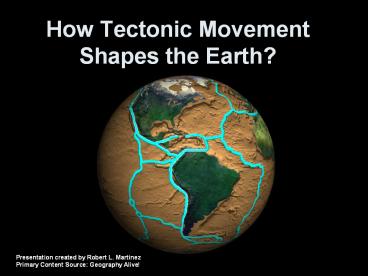How Tectonic Movement Shapes the Earth? - PowerPoint PPT Presentation
1 / 36
Title:
How Tectonic Movement Shapes the Earth?
Description:
How Tectonic Movement Shapes the Earth? Presentation created by Robert L. Martinez Primary Content Source: Geography Alive! Scientists solved the mystery of ... – PowerPoint PPT presentation
Number of Views:132
Avg rating:3.0/5.0
Title: How Tectonic Movement Shapes the Earth?
1
How Tectonic Movement Shapes the Earth?
Presentation created by Robert L.
Martinez Primary Content Source Geography Alive!
2
Scientists solved the mystery of earthquakes in
the 1960s. They discovered that the lithosphere
is broken into huge pieces called tectonic plates.
3
(No Transcript)
4
Earths lands and seas rest on these plates,
which lie below the surface of the planet. The
plates float like rafts on Earths liquid mantle.
5
Tectonic plates move in three ways. They can move
away from each other, they can move toward each
other, or they can scrape sideways past each
other.
6
When two tectonic plates collide, one plate
usually slides under the other.
7
Tectonic plates are incredibly heavy. When they
meet, friction can lock them into place for long
periods, allowing enormous pressure to build up
below Earths crust.
8
We feel this sudden movement as an earthquake.
9
When tectonic plates collide head-on, they can
build mountains in two ways.
10
The first way is when the pressure of colliding
plates forces Earths crust to fold, or wrinkle,
without breaking.
11
The resulting folds form mountains.
12
The Appalachian Mountains in the United States
and the Ural Mountains in Russia are examples of
fold mountains.
Team Martinez visiting the Appalachian Mountains
in 2008.
13
The second way in which colliding plates create
mountains is when their collision causes the
crust to crack into huge blocks.
14
The cracks between the blocks are called faults.
As pressure builds up, the blocks of crust tilt
and tip.
15
Then some tilted blocks slide upward along fault
lines to form mountains.
16
The Sierra Nevada mountain range in California is
made up of fault-block mountains, as is the West
Sayan range in Russia.
17
Russia covers a large part of both Europe and
Asia and includes several mountain ranges.
X
18
These mountain ranges tell the story of how
tectonic movement can shape a landscape.
19
The Ural Mountains in western Russia are
considered the dividing line between Europe and
Asia.
20
Even though Europe and Asia form one huge
landmass, this division into two continents makes
a good geographic sense.
x
21
The Urals mark the place where two tectonic
plates meet beneath Earths crust.
22
Over millions of years, pressure from these two
colliding plates has pushed the crust upward to
create the Urals.
23
The Urals slice through Russia from north to
south. This long chain of mountains separates the
Northern European Plain to the west from the West
Siberian Plain to the east.
24
The Urals are fold mountains, formed as the two
underlying plates caused Earths crust to
wrinkle.
25
In some places, erosion has worn down into
rolling hills.
26
Other parts of these mountains still have rugged
peaks.
27
Mount Manaraga in the northern Ural Mountains is
sometimes called Bears Paw because of its jagged
ridge.
28
The Caucasus Mountains are n southwestern Russia.
29
They run west to east on a narrow strip of land
between the Black Sea and the Caspian Sea,
marking a dividing line between Europe and Asia.
30
Like the Urals, the Caucasus Mountains are fold
mountains.
31
They also include volcanic formations and
glaciers, which still carve the jagged landscape.
32
Mount Elbrus, the highest peak in the Caucuses,
stands at 18,510 feet and is an extinct volcano.
33
The West Sayan Mountains are in southern Siberia,
just west of Lake Baikal.
34
Around Lake Baikal, major faults separate high
mountains and plateaus from deep valleys and
basins.
35
The West Sayan Mountains are fault-block
mountains. In this ranges, erosion has worn away
loose soil and rocks from the peaks.
36
This process has left behind steep ridges and
exposed layers of rock on the upper slopes of the
mountains.































